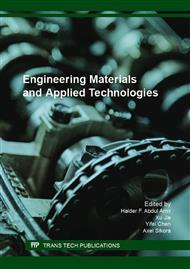[1]
V. W. Tam. Rate of Reusable and Recyclable Waste in Construction. J. Waste Management. 4 (2011) 28-32.
Google Scholar
[2]
M. F. Yusof. Study on Construction & Demolition Waste Management in Construction Site. UMP, Malaysia, (2006).
Google Scholar
[3]
Ramakrishna G. and Sundararajan T. Impact Strength of a Few Natural Fibre Reinforced Cement Mortar Slabs: A comparative Study. J. Cement Concrete Composite, 27(5)(2005a) 547-553.
DOI: 10.1016/j.cemconcomp.2004.09.006
Google Scholar
[4]
Ramakrishna G, Sundararajan T. Studies on the Durability of Natural Fibres and the Effect of Corroded Fibres on the Strength of Mortar. Cement Concrete Composites, 27(5)(2005b) 575-582.
DOI: 10.1016/j.cemconcomp.2004.09.008
Google Scholar
[5]
Agopyan V, Savastanojr H, John V, Cincotto M. Developments on Vegetable Fibre-cement Based Materials in Sao Paulo, Brazil: An Overview. J. Cement Concrete Composite, 27(5)(2005) 527-536.
DOI: 10.1016/j.cemconcomp.2004.09.004
Google Scholar
[6]
Fernandez J. E. Flax Fibre Reinforced Concrete - A Natural Fibre Bio Composite for Sustainable Building Materials, in High Performance Structures and Materials. Editors Seville. (2002) 193-207.
Google Scholar
[7]
Li Z, Wang L, Wang X. Cement Composites Reinforced with Surface Modified Coir Fibres. J. Composite Material. 41(12) (2007) 1445-1457.
DOI: 10.1177/0021998306068083
Google Scholar
[8]
Li Z., Wang X., Wang L. Properties of Hemp Fibre Reinforced Concrete Composites. Composite. Part A. Appl. Sci. Manuf., 37(3) (2006) 497-505.
DOI: 10.1016/j.compositesa.2005.01.032
Google Scholar
[9]
Toledo Filho R.D., Khosrow G., Sanjuan M.A., George L.E. Free, Restrained and Drying Shrinkage of Cement Mortar Composites Reinforced with Vegetable Fibres. J. Cement Concrete Composite. 27(5)(2005) 537-546.
DOI: 10.1016/j.cemconcomp.2004.09.005
Google Scholar
[10]
Majid Ali. (2012) Natural Fibres as Construction Materials,. Journal of Civil Engineering and Construction Technology Vol. 3(3) (2012) 80-89.
Google Scholar
[11]
Shamsudin., R. Daud., W.R. W, Takriff M.S., and Hassan O. Physicochemical Properties of the Josapine Variety of Pineapple Fruit. International Journal of Food Engineering. 3(5): Article 9 (2007).
DOI: 10.2202/1556-3758.1115
Google Scholar
[12]
R. Hemalatha and S. Anbuselvi. Physicohemical Constituents of Pineapple Pulp and Waste. Journal of Chemical and Pharmaceutical Research. 5(2) (2013) 240-242.
Google Scholar
[13]
Simon F. Thrush, Michael Townsend, Judi E. Hewitt, Kate Davies, Andrew M. Lohrer, Carolyn Lundquist, Katie Cartner. The Many Uses and Values of Estuarine Ecosystem Series in New Zealand, Conditions and Trends. Manaaki Whenua Press, Lincoln, New Zealand. (2013).
Google Scholar
[14]
Ming Kang, Jing Wang & Hongwen Huang, 2015. Nitrogen Limitation as a Driver of Genome Size Evolution in a Group of Karst Plants. Scientific Reports 5, Article number: 11636. (2015).
DOI: 10.1038/srep11636
Google Scholar
[15]
A. Ali, M. P. Abdullah, R. Hazizi, A. H. Marzuki, & R. B. Hassan. Protecting Coastal Habitats and Enhancing Fisheries Resources Using Big Size Artificial Reefs in the East Coast of Peninsular Malaysia. Malaysian Journal of Science. 32 (2012).
DOI: 10.22452/mjs.vol32no3.3
Google Scholar
[16]
R. L. Sherman, D. S. Gilliam, & R. E. Spieler. Artificial reef design: void space, complexity, and attractants. ICES J. of Marine Science. 59(2002) 196–200.
DOI: 10.1006/jmsc.2001.1163
Google Scholar
[17]
M. S. Ammar. Coral Reef Restoration and Artificial Reef Management, Future and Economic. The Open Environmental Engineering Journal. 2 (2009) 37-49.
DOI: 10.2174/1874829500902010037
Google Scholar
[18]
H. Pyar, M. T. Liong & K. Peh. Potentials of Pineapple Waste as Growth Medium for Lactobacillus Species. J. Pharmacy and Pharmaceutical Science. 6 (2003)142-145.
Google Scholar
[19]
D. S. Rani & K. Nand. Ensilage of Pineapple Processing Waste for Methane Generation. J. Waste Management. 24 (2004) 523-528.
DOI: 10.1016/j.wasman.2003.10.010
Google Scholar
[20]
K. Z. Nadzirah, S. Zainal, A. Noriham, I. Normah, A. M. Roha & H. Nadya. Physico-Chemical Properties of Pineapple Variety N36 Harvested and Stored at Different Maturity Stages. J. Food Research Journal. 20 (2012) 225-231.
DOI: 10.1016/j.apcbee.2012.11.022
Google Scholar
[21]
Samir N. Shoukry, Gergis W. William, Mourad Y. Riad, Brian Downie. Effect of Moisture and Temperature on the Mechanical Properties of Concrete. Proceedings of the SEM Annual Conference. (2009).
Google Scholar
[22]
Fernando Martínez, Belén González. Shear Strength of Concrete With Recycled Aggregates. National Conference. 1-10. (2005).
Google Scholar


